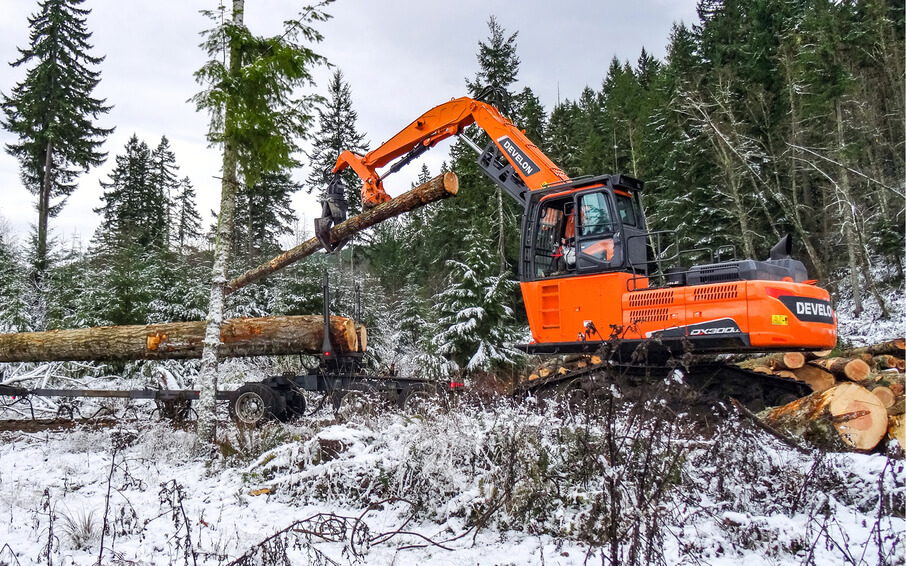How to Winterize Logging & Forestry Heavy Equipment
- 30/04/24
- read

Forestry heavy equipment, such as log loaders, is designed to work hard in challenging environments and climates. But for a longer life and better performance, it requires proper maintenance — especially when cold conditions arrive.
Harsh temperatures can put additional stress on your equipment and lead to potential downtime if your machines aren’t properly winterized.
Follow a good preventive maintenance schedule to better prepare your forestry heavy equipment for winter logging.
Here are nine tips for winterizing your forestry equipment.
1. Review the Operation & Maintenance Manual
Always refer to the Operation & Maintenance Manual for recommended maintenance intervals, a checklist of seasonal maintenance items and oil and fluid recommendations.
The Operation & Maintenance Manual will explain which machine components should be regularly inspected, including fluids and filters, the battery, tire pressure for wheel loaders, grease intervals and heating and defrosting systems.
By running a good preventive maintenance program, as outlined in the Manual, you can better prepare your equipment for winter.
Contact your local DEVELON dealer if you no longer have a copy of the manual. Electronic copies are available upon request.
2. Switch to Winter Fuel in Cold Conditions
Come winter and cold conditions, switch to the appropriate diesel fuel. Diesel is commercially available in many grades, the most common being No. 1, No. 2 and a winterized blend.
No. 1 grade diesel fuel has lower energy components than its counterpart, No. 2 grade, because paraffin (a type of wax) has been removed from the chemical mix.
The absence of this chemical allows it to remain in liquid form during winter logging months. The downside of No. 2 diesel is its tendency to transform into a thickened gel when the temperature drops. This often leads to hard starts and other complications during winter.
Winterized fuel is a combination of No. 1 and No. 2 fuels. When mixed, they contain a higher concentration of No. 1 grade fuel and are used when it becomes too cold, starting at 14°F.
The combination of both grades should contain enough energy components and lubricant properties to reduce the chance of the chemical mix gelling in colder temperatures.
Investing in quality fuel blended appropriately for the climate and season may give you better peace of mind, lower your consumption, provide fewer filter changes and deliver long component life.
Refer to the Operation & Maintenance Manual for proper fueling procedures.
3. Use Winter-Blend Engine Oil
Different engine oils are needed for different climates and vary based on ambient temperatures.
We recommend using 10W40 genuine engine oil to protect the machine’s vital engine components if you are working in a climate ranging from 0°F to 100°F. If you are in a climate colder than 0°F, then switch to a different blend engine oil, like 5W40.
If you don’t use the right engine oil for your forestry equipment, colder temperatures can affect its ability to run efficiently. This can cause costly damage to your machine’s internal components, which can become plugged, corroded and, ultimately, not work efficiently.
Your Operation & Maintenance Manual lists instructions for filling your equipment at the recommended intervals with the appropriate fluid in the correct increments.
4. Inspect the Battery
Check your battery, wires and hoses to make sure they haven’t frozen or become stressed during cold conditions. There is always a draw on the battery, so make sure it’s fully charged prior to being used.
In ideal conditions where the temperature is 75°F, you can expect to get 95% to 99% capacity out of the battery.
But if the temperature is 32°F, the battery would only deliver around 75% of its capacity. In certain extremely cold applications, where the temperature is 0°F or lower, delivered power can be as low as 40%.
Connect a trickle charger to help build the voltage at a lower rate, which can improve battery life. Older, weaker batteries should be replaced.
Also, inspect and clean the battery connections. Corroded terminals can cause hard starting and charging issues. You can also use a battery blanket to help keep the battery warm when your machine is not in use.
5. Check Diesel Exhaust Fluid
Diesel exhaust fluid (DEF) is now used in almost all Tier 4 Final engines, and it will freeze in temperatures below 32°F. When filling the fluid, leave room for expansion, as DEF can swell in volume in the winter months.
Storing DEF in the shop or fueling area is another consideration. Make sure you’ve stored your bulk supplies of DEF where they can’t freeze; otherwise you’ll have to thaw them out before dispensing.
6. Change the Coolant
Coolant is critical in winter to help protect your engine from freezing. As you run the engine, inspect the coolant and make sure it is free of impurities.
If the coolant in your engine needs to be replaced, choose the best grade for your machine and region. For your machine to perform well in colder weather, the antifreeze mix must be properly blended.
To prevent the coolant from freezing in subzero temperatures, use a 50/50 mix of antifreeze and water. In the less severe cold you can use a higher percentage of water, like 60/40.
7. Use a Block Heater for Heavy Equipment
Warm up the engine with a block heater before starting work — it’s available as an option on most forestry heavy equipment.
Using the heater makes it easier to start the machine as well as reduces wear on engine components. Waiting for the engine oil and coolant to heat up helps ensure you won’t damage the engine.
8. Warm Up the Engine
If you are using your forestry equipment in the winter, run the engine for 5 to 10 minutes after starting. There’s no need to run the engine any longer than a few minutes.
Giving the engine a chance to warm up makes it easier on your equipment and essential components.
9. Store Equipment Properly
If you decide to not use your equipment until the ground thaws, follow these storage procedures.
- Clean the machine and its undercarriage.
- Check fuel, oils and filters.
- Disconnect the battery.
- Protect equipment from the elements in an enclosed, heated facility or out of the wind.
- Prep and lower attachments to the ground.
Don’t let winter logging weather wreak havoc on your forestry heavy equipment. By following these tips, you can better prepare your machines for whatever winter brings.
Need a durable machine to handle timber with precision? Explore our high-performance DEVELON log loaders.
 Looking to purchase our collection?
Looking to purchase our collection?
Write to us at info@elvaan.com and
add subject line 'Got Swag'
-
Mississauga
2355, Cawthra Road, Mississauga, Ontario
L5A 2W7 -
Orillia
47 Forest Plain Road, Oro-Medonte, Ontario L3V 0R4
-
Edmonton
10807-209 St, Edmonton, Alberta T5S 1Z7













